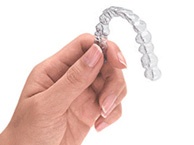What’s better: Veneers or braces?
One of the most common questions our expert orthodontists and cosmetic dentists receive is “which is better – veneers or braces?”
A difficult question to answer simply, it entirely relies on your unique orthodontic condition and the amount of time you are willing to commit to a procedure.
Both procedures offer alignment, aesthetic improvements and great results, but the two treatments, whilst both fix and treat the same problems, are entirely different.
For any help making the decision, or if you require individual professional dental advice, book a free consultation using the button below.
Cosmetic braces
When it comes to severe malocclusions like overbites, underbites, open bites and excessive crowding, braces might be the best option.
Whilst veneers are good for cosmetic issues in nature, they are more commonly prescribed in cases of mild misalignment, gaps, crowding, staining and discolouration.
Braces will do the hard work by physically moving incorrectly positioned teeth into their correct alignment, whereas veneers will simply conceal the problem rather than correct it.
Read: How to fix narrow smiles.
Brace advantages:
- A non-invasive way to treat the smile
- Correct misplaced teeth safely
- Improves oral health, hygiene and structure
The brace commitment
 Some people may opt not to have braces because of the stigma that surrounds them or the time they take for the treatment to complete.
Some people may opt not to have braces because of the stigma that surrounds them or the time they take for the treatment to complete.
However, what might not be common knowledge is innovative and modern alignment techniques that are storming the dental market.
Using cosmetic braces instead of traditional, fixed braces can save you a lot of time as they can straighten teeth a lot quicker.
In comparison to conventional braces, which can be uncomfortable or painful, new systems like Invisalign use a series of clear aligners that straighten the teeth in twice the time and requires less dental office visits.
Known for its discreet and invisible properties, Invisalign has allowed a lot of adults to undergo the teeth straightening method privately and discreetly. See more benefits.
Read more:
- Invisalign consultation
- What you need to know about wearing Invisalign
- Aftercare
- Treatment length
- Invisalign vs clear aligners
- Price
Meet our Invisalign co-ordinator.
Types of new innovative brace systems:
Other types of braces:
- Fixed Braces: Traditional, fixed metal bracket braces. Discover.
- Inman Aligners: A revolutionary way to straighten the teeth, Inman Aligners can take anywhere from 6-16 weeks.
- Ceramic Braces: These are fixed but are tooth-coloured so are not so obvious to the eye. Discover.
- Instant Orthodontics: This often refers to veneers, which give patients an instant straight and natural-looking smile. See porcelain veneer benefits.
Be conscious of retention or relapse
 Once the teeth have been moved into the correct position, it is important to ensure they retain their new position.
Once the teeth have been moved into the correct position, it is important to ensure they retain their new position.
This is completed through wearing retainers – the amount of time you will need to wear this for will depend on your unique condition.
Every detail of your orthodontic treatment from start to finish will be mapped out on in your tailored treatment plan, which will be created after an orthodontic consultation.
Let us help you decide
It’s always best to know the options available to you.
Our experienced cosmetic dentists and orthodontists all have extensive experience and are highly-rated in their specialist fields.
Depending on your oral condition, you may require straightening and veneers, this is because misalignment issues can also cause a lot of negative outcomes such as chips and fractures.
Learn more about veneers:
- Aftercare
- Our approach to veneers
- Lumineers vs veneers
- Can they last forever?
- Painless and minimally invasive application
- Cost
These can easily be repaired by composite veneers, which is also a non-invasive way to correct your smile.

